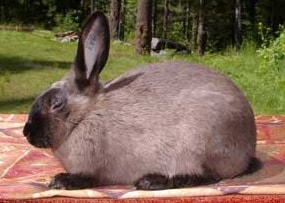Type the name of the breed you're looking for below
[wpdreams_ajaxsearchlite] Don't see the breed your're looking for? Click here and let us know!
Breed Characteristics
1 paw - breed exhibits the least amount of this characteristic
5 paws - breed exhibits most amount of this characteristic
American Sable rabbit
| Origin | The American Sable is one of those little-known breeds that is actually very handsome and useful. It has commercial body type and is suitable for 4-H meat pen project, if you’d like to try something different from the usual Cal’s and New Zealands. The namesake feature of this breed is its lovely sable color. The back of the rabbit is rich sepia brown, which lightens on the rabbit’s sides and darkens to nearly black on the nose, ears, feet, and tail. This breed is not very popular, but not in imminent danger of extinction thanks to a community of breeders who call themselves “Sablers.” The American Sable has regular commercial type, but is slightly smaller than other commercial breeds such as the Satin or Californian. This is a tricky one for ARBA royalty participants, who must remember that although a fairly large rabbit, it is actually a four-class breed. The Sable colouration is caused by a gene called “chinchilla light,” symbolized by cchl or cch1. This gene is incompletely dominant over the two below it (Himalayan and REW.) When a rabbit has two copies of cchl, it looks so dark brown as to be almost black. This colour is called seal. A correctly coloured sable has one copy of cchl and one copy of a lower C-series allele: Himalayan or REW. Therefore, breeding two correctly coloured sables can result in seal, Himalayan, or ruby-eyed white offspring. The non-showable colours are useful to a breeding program, however, because breeding a seal to a himie or REW will result in 100% correct sables. Some breeders have crossed Californians (Himalayan-coloured breed) into their American Sables to improve type and add some genetic diversity. As is the case with any crossbreeding project, you will find some people for and others strongly against this practice. A perfectly coloured Sable is difficult to produce. Any blotchiness of shading –which can be easily caused by sunburn or molt — is a fault. The eyes must possess a ruby glow to avoid disqualification on the show table. A white toenail is also cause for disqualification. The colour sable is now found in many rabbit breeds, but it first appeared in litters of Standard or American Chinchillas in the 1920’s. Breeders started developing these shaded bunnies and they were accepted into the standard in 1931. The darkest period in the breed’s history was in the early eighties, when it would have probably been dropped from the ARBA standard if not for the dedicated effort of an Ohio breeder, Al Roerdanz. Ohio remains one of the strongholds of the American Sable today. |
Physical Attributes
| Weight | 7 - 10 lbs. (3.2 - 4.5 kg) |
| Ear Type | Erect |
| Fur Type | Rollback |
| Colours | The head, feet, ears, back, and top of the tail are a dark sepia, while the coat fades to a lighter tan over the rest of the body, similar to the colouring of a Siamese cat. |
| Appearance | Nose, ears, feet, and tail very fark brown, body a sepia color. Body is medium long and full, head narrow, and ears long and erected. |
| Other Considerations | The American Sable enjoys the company of other rabbits. It is generally docile, spending most of the day sleeping. Typically they enjoy the companionship of their owner, but on their own terms. When distressed, the American Sable will make a grunting noise or will, like many other breeds, thump its back foot on the ground in an attempt to scare whatever it is that is bothering them. Life Expectancy: 5-8 years Temperament: Gentle |
| Best Kept In | Pen. Shed, House or Yard. |



